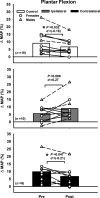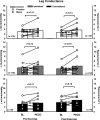Central and peripheral modulation of exercise pressor reflex sensitivity after nonfatiguing work
- PMID: 32877237
- PMCID: PMC7789962
- DOI: 10.1152/ajpregu.00127.2020
Central and peripheral modulation of exercise pressor reflex sensitivity after nonfatiguing work
Abstract
Autonomic blood pressure control is fundamentally altered during a single bout of exercise, as evidenced by the downward resetting of the baroreflex following exercise (postexercise hypotension). However, it is unclear if an acute bout of exercise is also associated with a change in the sensitivity of the exercise pressor response to a controlled stimulus, such as a static contraction. This study tested the hypothesis that the blood pressure response to a controlled static contraction would be attenuated after unilateral cycling of the contralateral (opposite) leg, but preserved after cycling of the ipsilateral (same) leg. To test this, the blood pressure response to 90 s of isometric plantar flexion [50% maximal voluntary contraction (MVC)] was compared before and after 20 min of contralateral and ipsilateral single-leg cycling at 20% peak oxygen consumption and rest (control) in 10 healthy subjects (three males and seven females). The mean arterial pressure response was significantly attenuated after contralateral single-leg cycling (+9.8 ± 7.5% ∆mmHg vs. +6.7 ± 6.6% ∆mmHg pre and postexercise, respectively, P = 0.04) and rest (+9.0 ± 7.5% ∆mmHg vs. +6.6 ± 5.2% ∆mmHg pre and postexercise, respectively, P = 0.03). In contrast, the pressor response nonsignificantly increased following ipsilateral single-leg cycling (+5.5 ± 5.2% ∆mmHg vs. +8.9 ± 7.2% ∆mmHg pre and postexercise, respectively, P = 0.08). The heart rate, leg blood flow, and leg conductance responses to plantar flexion were not affected by any condition (P ≥ 0.12). These results are consistent with the notion that peripheral, but not central mechanisms promote exercise pressor reflex sensitivity after exercise.
Keywords: autonomic; blood pressure; neurovascular; pressor response.
Conflict of interest statement
No conflicts of interest, financial or otherwise, are declared by the authors.
Figures





Similar articles
-
Effects of exercise pressor reflex activation on carotid baroreflex function during exercise in humans.J Physiol. 2001 Jun 15;533(Pt 3):871-80. doi: 10.1111/j.1469-7793.2001.t01-2-00871.x. J Physiol. 2001. PMID: 11410642 Free PMC article.
-
Peripheral revascularization attenuates the exercise pressor reflex and increases coronary exercise hyperemia in peripheral arterial disease.J Appl Physiol (1985). 2018 Jul 1;125(1):58-63. doi: 10.1152/japplphysiol.01046.2017. Epub 2018 Apr 12. J Appl Physiol (1985). 2018. PMID: 29648515 Free PMC article.
-
Cardiovascular responses to static handgrip exercise and postexercise ischemia in heart failure with preserved ejection fraction.J Appl Physiol (1985). 2023 Jun 1;134(6):1508-1519. doi: 10.1152/japplphysiol.00045.2023. Epub 2023 May 11. J Appl Physiol (1985). 2023. PMID: 37167264 Free PMC article.
-
The interaction of central command and the exercise pressor reflex in mediating baroreflex resetting during exercise in humans.Exp Physiol. 2006 Jan;91(1):79-87. doi: 10.1113/expphysiol.2005.032110. Epub 2005 Nov 1. Exp Physiol. 2006. PMID: 16263799
-
Identifying the role of group III/IV muscle afferents in the carotid baroreflex control of mean arterial pressure and heart rate during exercise.J Physiol. 2018 Apr 15;596(8):1373-1384. doi: 10.1113/JP275465. Epub 2018 Mar 2. J Physiol. 2018. PMID: 29388218 Free PMC article.
Cited by
-
Single-leg cycling to maintain and improve function in healthy and clinical populations.Front Physiol. 2023 Apr 28;14:1105772. doi: 10.3389/fphys.2023.1105772. eCollection 2023. Front Physiol. 2023. PMID: 37187959 Free PMC article. Review.
-
Exercise pressor responses are exaggerated relative to force production during, but not following, thirty-minutes of rhythmic handgrip exercise.Eur J Appl Physiol. 2024 May;124(5):1547-1559. doi: 10.1007/s00421-023-05390-2. Epub 2023 Dec 29. Eur J Appl Physiol. 2024. PMID: 38155209
References
-
- Black MI, Jones AM, Blackwell JR, Bailey SJ, Wylie LJ, McDonagh ST, Thompson C, Kelly J, Sumners P, Mileva KN, Bowtell JL, Vanhatalo A. Muscle metabolic and neuromuscular determinants of fatigue during cycling in different exercise intensity domains. J Appl Physiol (1985) 122: 446–459, 2017. doi:10.1152/japplphysiol.00942.2016. - DOI - PMC - PubMed
Publication types
MeSH terms
Grants and funding
LinkOut - more resources
Full Text Sources
Medical

